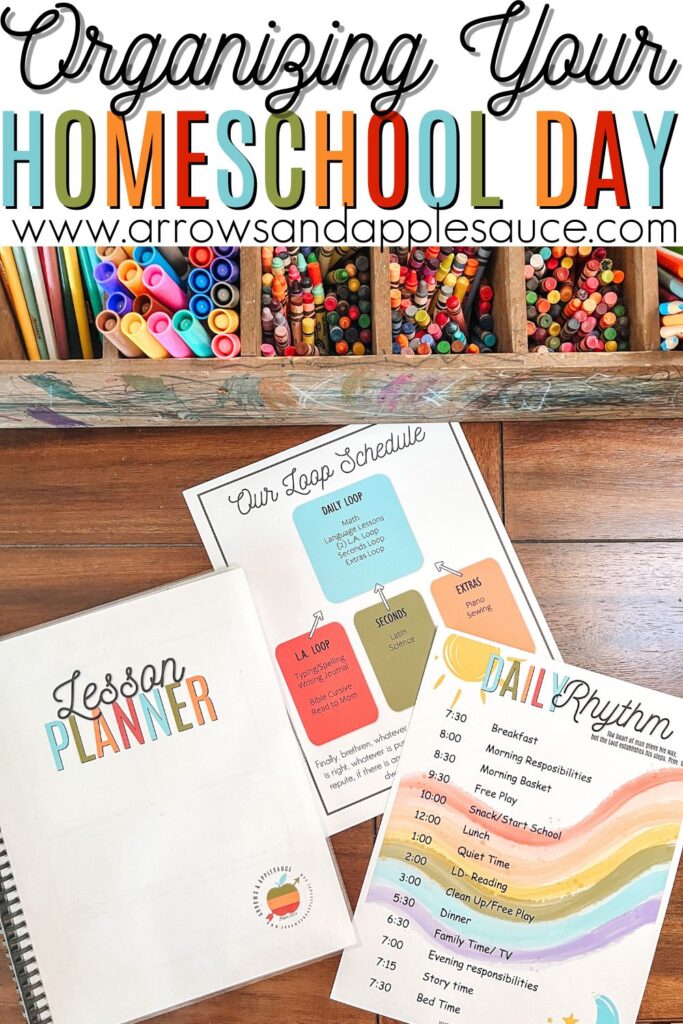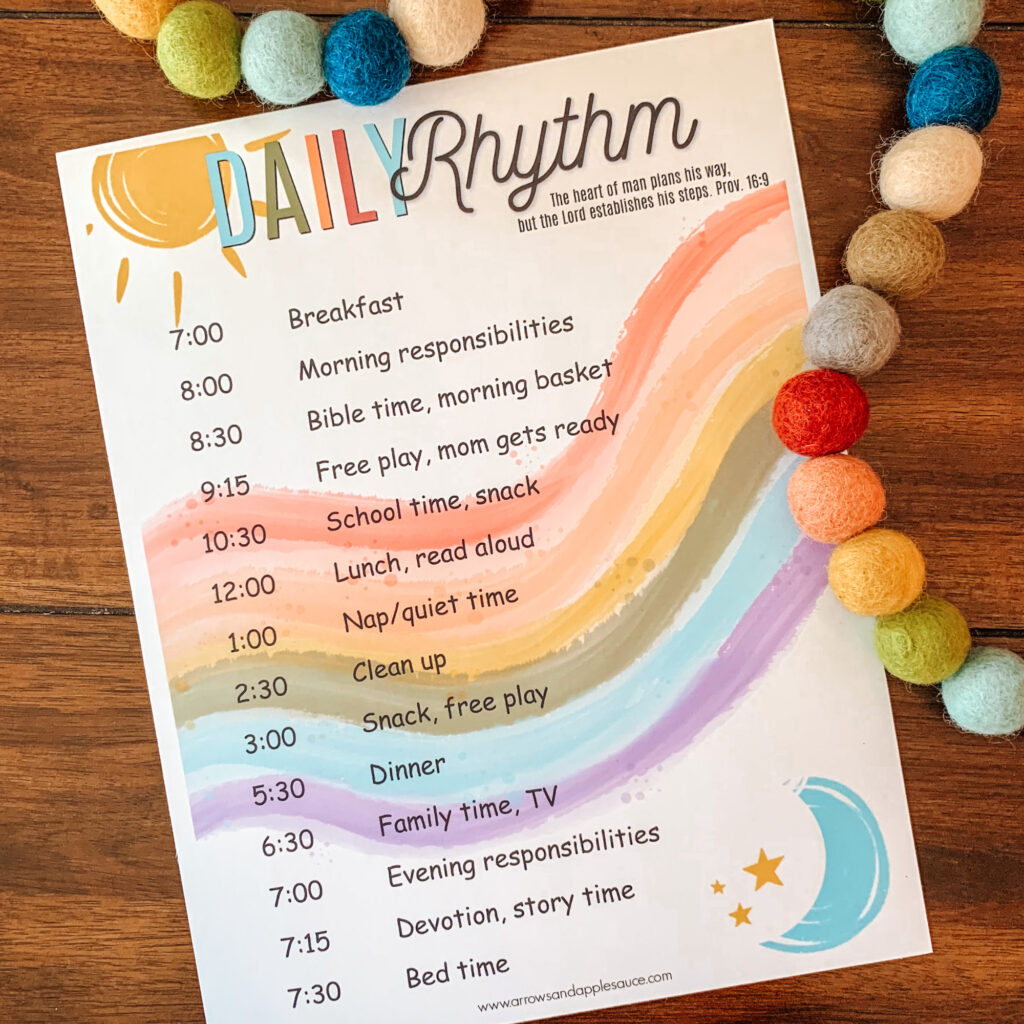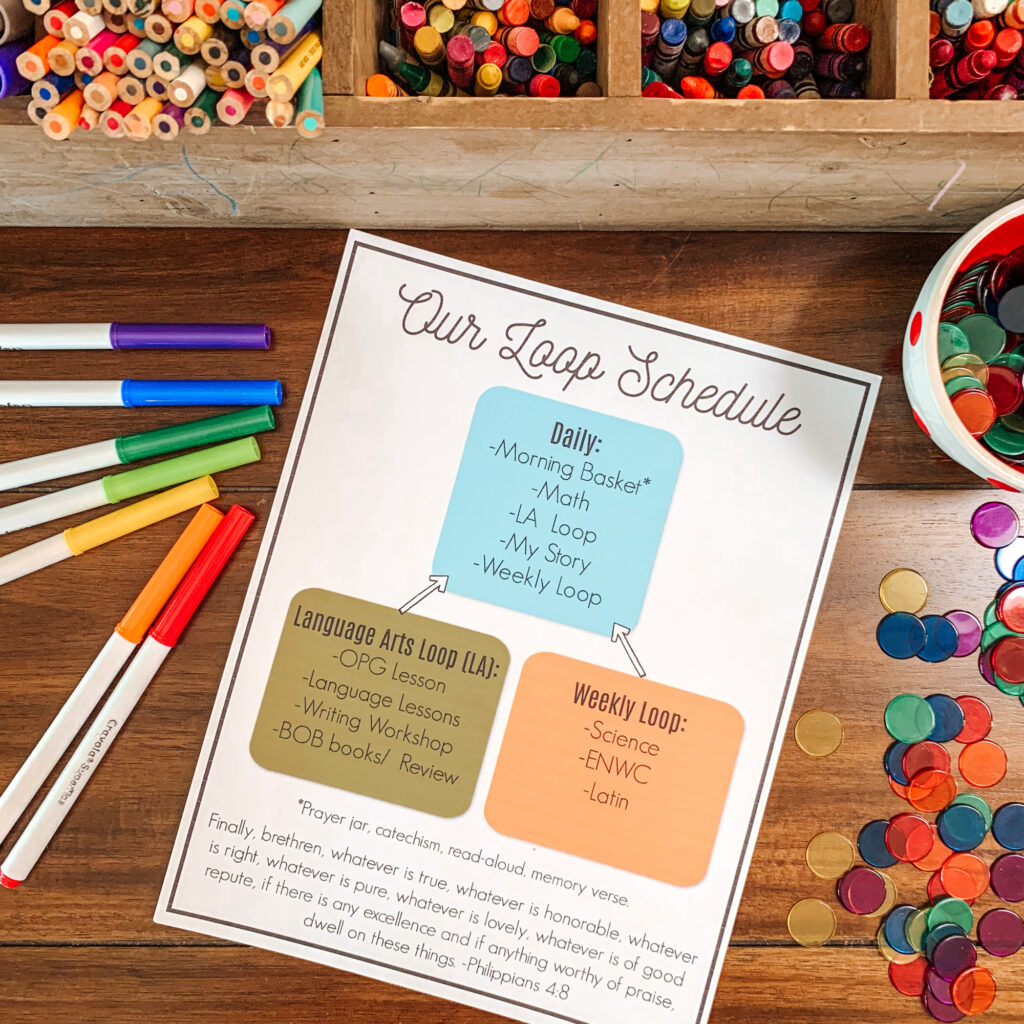This post contains affiliate links. If you follow one of my links I earn a small commission at no extra cost to you. All opinions are completely my own. Thank you for supporting my blog!
Every once in a while there’s an uptick in a certain question from this wonderful community. It’s a little reminder to me that a blog post might be helpful. In the past few weeks, I’ve received multiple questions relating to how we organize our homeschool day, and how I schedule our time with three little learners, all at different ages. After answering a few times I decided it would be good to have all of this information in one place.
 Time is on everyone’s mind and I understand that overwhelmed feeling of not knowing how it’s all going to work. How will it all fit in?! We all only get 24 hours and somewhere in there, we have to sleep. Organizing the other 16 hours a day (I’m being optimistic about the amount of sleep we’re all getting) seems like a huge priority.
Time is on everyone’s mind and I understand that overwhelmed feeling of not knowing how it’s all going to work. How will it all fit in?! We all only get 24 hours and somewhere in there, we have to sleep. Organizing the other 16 hours a day (I’m being optimistic about the amount of sleep we’re all getting) seems like a huge priority.
I’m gonna tell you now, there’s no trick. There’s no way to add extra hours. There’s no life hack that can make you Super Mom, immune to interruptions and challenges. If it’s a priority, it’ll get done.
For me, homeschooling is a priority. One of the highest. So I’ve taken the time to organize…well, time.
First, I’ve created a daily rhythm (an editable version is available to you in my shop). It’s my ideal flow to a full day at home.
A daily rhythm helps me have a goal for what I’d like the day to look like, but I know full well it most likely won’t. And that’s ok! Flexibility is key.
Our daily rhythm is a map. I can glance at it, check the clock, and know how to adjust our time accordingly if possible. It gives me an idea of how long I want to spend on any given subject in our routine, or it can tell me what needs to be skipped over to accomplish a bigger goal that day. For example, should we skip a little quiet time to accommodate a trip to the library? Do we need to move lessons up to fit in a dentist appointment? Our daily rhythm is the starting point, not the requirement.
 Get your editable Daily Rhythm here!
Get your editable Daily Rhythm here!
Once I have an idea of what I want our day to look like I can go over our loop schedule. A loop schedule focuses solely on what we need to accomplish during our homeschool day.
I’ve written about these a few times in the past, and have had different styles of loops. Even though I have created loops for preschool in the past (enthusiasm can get the better of me sometimes), I don’t think they’re much use before kindergarten or first grade. Even then a kindergarten loop would be more about building the habit of using one. A loop schedule for our homeschool day tells me what subjects we need to cover. This is separate from what’s covered during morning basket, which is a whole other topic. If a topic is skipped or forgotten we can simply add it the next day or the next time we come to it in the loop.
 Get your editable Daily Loop Schedule here!
Get your editable Daily Loop Schedule here!
I use my file system to organize paper worksheets that we might use during our homeschool day.
Our file system gets set up at the beginning of the school year and helps our days move so much more smoothly. I can look at our loop to see what subjects we’re covering that day. Then I’ll go to our file for the week, and pull out any worksheets we will need.
After I have our worksheets pulled out I clip them onto each kid’s clipboard. Our clipboards open and have space for storing pencils, rulers, erasers, and any other school supplies we use frequently. It keeps each child’s preferred tools separated and organized.
Next, I’ll stack the clipboards and any additional books together on our table for use during lessons. Gathering everything at the beginning of each day (or after morning basket) helps us stay on task. No stopping mid-lesson to search for a book.
 Read more about our file system here!
Read more about our file system here!
Every season and each unique lifestyle will dictate how you choose to work with each of your kids.
When I had little ones who still napped, I would do individual lessons with my oldest during nap time. As my younger two outgrew naps, there was a season where I saved their screen and snack time for my oldest’s school time. I’d put on an educational show, dole out the Goldfish, and buy us at least 30 minutes of uninterrupted lessons. I know this may be against the screen-free grain, but it worked for the short season in which it was needed.
Now that my older two are in first and third grade, I alternate their individual lessons.
I’ve also given my third grader a lot more independence this year. Since she’s a strong reader and has a self-starter personality anyway, I’ve let her take the reins on a good number of her individual lessons.
For example, while I’m doing math with my first grader, my third grader takes her math to her room to work independently (you can see what curriculum we’re using for kinder and first grade here, and third grade here). Once they’re both done, my oldest will come do language arts with me and my first grader will take a brain break to play with his little brother and get a snack.
I will say I have been blessed with a very go-with-the-flow third born. My five year old will generally play on his own without an issue during the 20 minutes or so the other two are doing math. Switching back and forth like this, is working in this season. Kindergarten with my five year old is very simple (again, see our kinder curriculum choices here). It gets worked into our homeschool day whenever he’s in the mood, which is usually three to four times a week, about 20 minutes a day.

Get your editable planner here!
Once we’re done with our lessons for the day, I reverse plan and write down what we accomplished.
Reverse planning is exactly what it sounds like. I use the the editable planner I created to write down the subjects we covered from our loop schedule. So instead of writing what we hope to get to, I write down what got done. This is much more practical and way less stress-inducing in my opinion. With everything laid out in my planner, I can see if anything was accidentally skipped in our loop or if something needs to be covered more in-depth. If I wrote it all out before hand, it would just be extra work and too overwhelming. This keeps us on track but still allows for that all-important flexibility.
I have accepted that our daily rhythm, how we get through our school work, and the order we do things will change.
Tools like my printed daily rhythm, loop scheduling, file system, and reverse planning help things go as smoothly as possible. Just like everything else in life though, hold the plan loosely, and embrace the season you’re in.
Emily says
The filing system you use has been such a blessing to our family! Our daughter started first grade this year and the extra work before the school year began was definitely worth it, especially since we’re expecting a baby in January. Instead of backwards planning, I made an undated schedule laying out all of the subjects by week (and putting worksheets in the appropriate weeks’ files), then highlight what gets done as it’s completed and date the subjects as needed. This system was very helpful when we spent most of October moving and our homeschool rhythm got a little wacky. So thankful I found your blog post about the filing system. It was a huge lifesaver for my sanity. Ha!